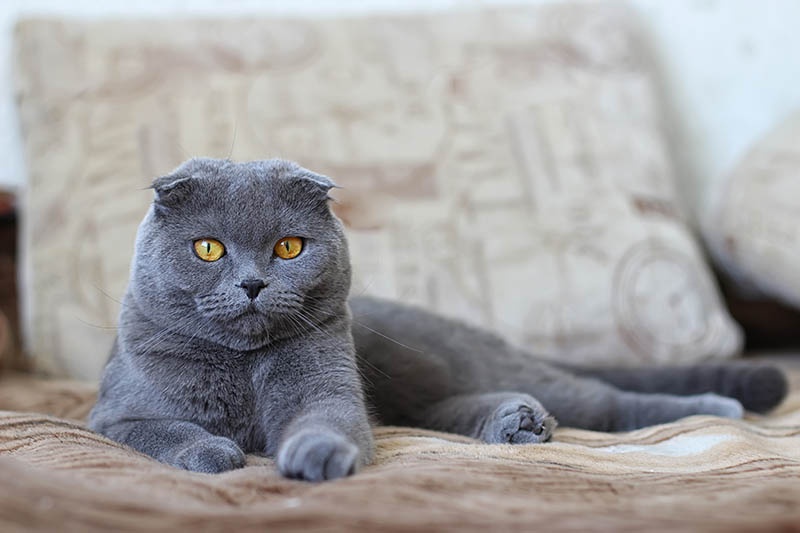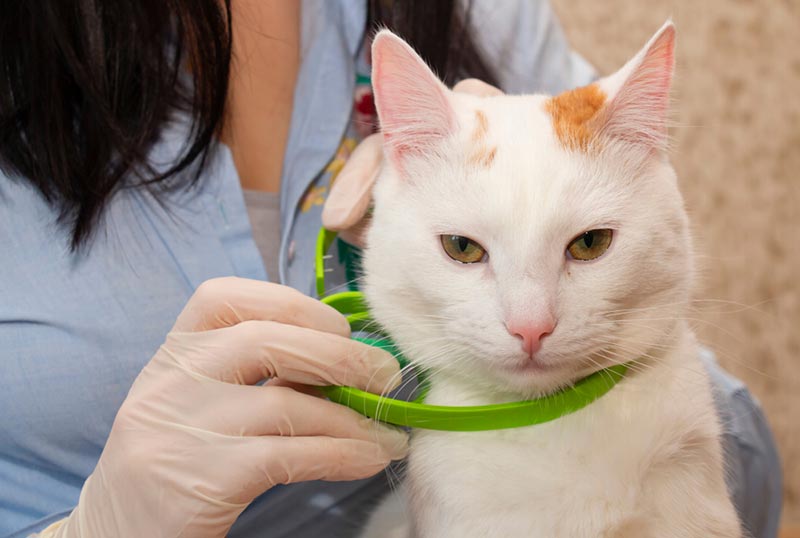Are Cats Ticklish? Signs, Facts, & FAQ
Updated on
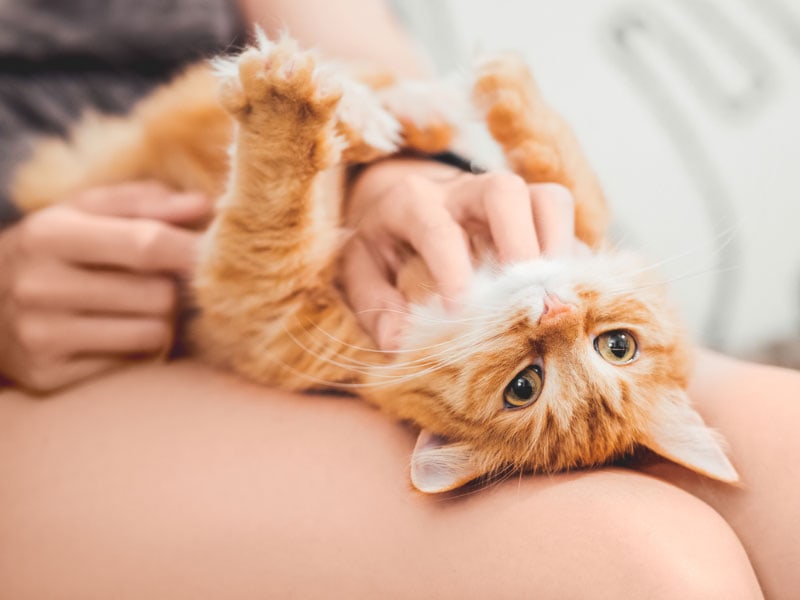
Most people are ticklish to varying degrees, and a good-natured tickle in the right spot often results in giggles or hoots of laughter. Surely, if humans are capable of experiencing this unique sensation, other animals, such as our beloved feline friends, are too? But cats don’t laugh or giggle, so how can we be sure?
We can’t be entirely sure, but scientists and animal behaviorists are relatively certain that cats are ticklish. However, how they experience this phenomenon may differ slightly from how humans do. As does their response.
How Are Cats Ticklish?
Ticklishness can be a pleasant or uncomfortable experience for cats. The unofficial scientific term for pleasure or irritation-inducing ticklishness resulting from gentle scratching is knismesis. There is another kind of ticklishness called gargalesis which humans and other primates experience.

Gargalesis
This laughter-inducing tickling results from intentional poking and prodding. While humans find this irresistible, there are no indications that cats experience this kind of tickle sensation. They certainly do not enjoy firm pokes and prods of any description and will reward you with a well-aimed swat if you try to engage with them that way!
Knismesis
One school of thought is that knismesis evolved in animals as a means of external parasite control. The movement of parasites such as ticks, fleas, and flies on the skin also induces knismesis. As a result, the animal feels the urge to scratch or rub their skin to rid themselves of the irritant. It seems as if there’s a fine line between annoyance and pleasure!
Your kitty can distinguish between pleasurable knismesis from your tickles and scratches and knismesis from some irritating pest. They will respond accordingly in each case. However, you will probably have noticed that your loving cat will not endure caresses and tickles indefinitely. They have their limits and will let you know when they have had enough. This may be the point at which the knismesis loses its pleasurable effect.
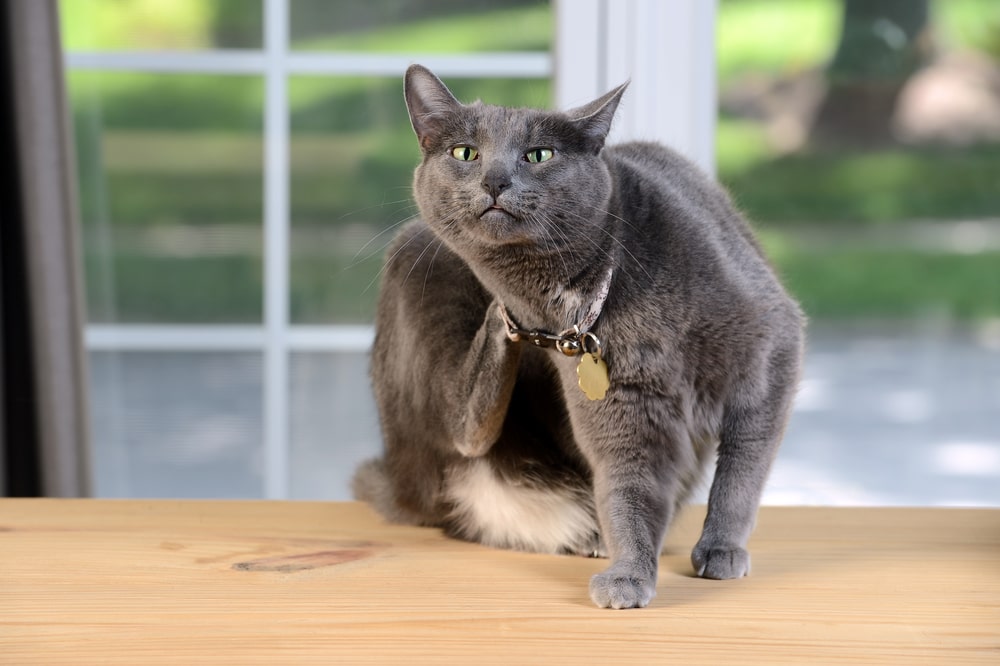
Do Cats Like Being Tickled?
Most cats love a good tickle, caress, or scratch from a human, another cat, or even another household pet. This could be due to the pleasing effect of knismesis or simply because of the emotional reward of bonding with the tickler, which is usually a trusted and loved family member.
However, all cats are different; some either don’t like to be petted or touched or tolerate it in tiny amounts. It’s essential to be able to read your kitty to be sure that you are not overstepping their boundaries and causing distress.
Signs That a Cat Either Enjoys or Hates Being Tickled
A cat can’t tell you in words to keep tickling or to stop, but they communicate in so many other ways. Their body language, actions, and sounds will give you a clear indication of whether they are enjoying an experience or not.
These are some of the signs that your cat enjoys your tickles and scratches:
- Purring accompanied by relaxed body language
- Half-closed eyes with blinking and winking
- Leaning or turning into your tickles
- Adjusting their position to enjoy more tickles
- Sweet, chirrupy meows
- Pulling your hand back if you stop tickling or nudging you for more
- Kneading with their front paws
Tickling can cause overstimulation of their senses, and the point will come when they have had enough. This happens at different times for different cats and never for some! Sometimes they will fall asleep; other times, they will give you clear indications that your services are no longer required. Pay careful attention to the following cues so you don’t overstep your feline’s boundaries and ruin a beautiful moment!
- They stop purring
- Twitching skin in response to or in anticipation of being touched
- Their body becomes more rigid, with their head more upright
- Their Ears begin to turn back or flatten
- Their tail begins to twitch in an agitated manner
- Wide eyes or angry half-closed eyes that don’t blink
- They move away
- Pushing, swatting, or kicking your hand away
- Biting your hand
- Growling
- Low-pitched yawling
These cues are listed in order of ascending irritability. It’s best to heed their request and leave them alone before they escalate to biting and growling!
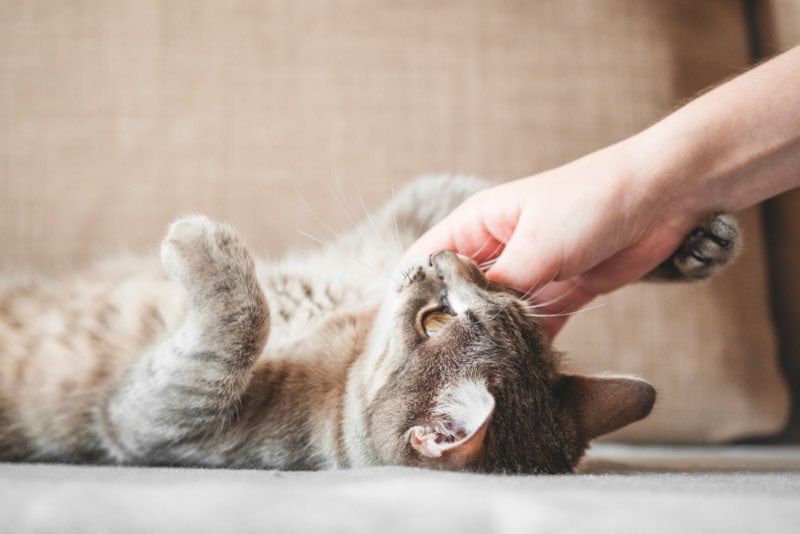
Which Parts of a Cat Are the Most Ticklish?
There are a few spots on their bodies that almost all cats enjoy having scratched or tickled. The areas that most cats enjoy being scratched or tickled are their head, cheeks, and chin. Many cats also enjoy being stroked or gently tickled with fingernails down their back, stopping before their tail. Some cats will not let you touch them, and others will not allow you to pet them anywhere other than on their head.
Cats are also very ticklish in other areas, but the sensation of being tickled in some areas is not always pleasant. If they trust and love you, they may allow you to touch them on their tummy, foot pads, and soft parts of their ears. However, they only tolerate caresses in these areas to demonstrate trust rather than enjoy it.
Should I Tickle My Cat? If So, How?
With their consent, you can tickle your beloved fur friend! It’s an excellent way to bond with your feline and deepen your trust and understanding of one another. Cats are unlike dogs because they are less appreciative of brusque, off-hand pats and caresses.
You need to approach a cat with more consideration and deference. Before you physically interact with a kitty, particularly one you don’t know, it’s best to engage with them verbally and visually. In this way, they become aware of your intentions and are given a chance to accept or reject any further advances. That is when you look for the cues listed above that inform you of their mood and preferences.
Once you get to know your cat, you can develop a more instinctive understanding of their boundaries. You will know which parts of their body they enjoy having scratched and tickled, how firm the tickles should be, and for how long.
You may even discover that your cat has a sweet spot specific only to them! And you will also know to respect them when they’ve had enough. The last thing you want to do is upset the peace by displeasing the boss of the house!
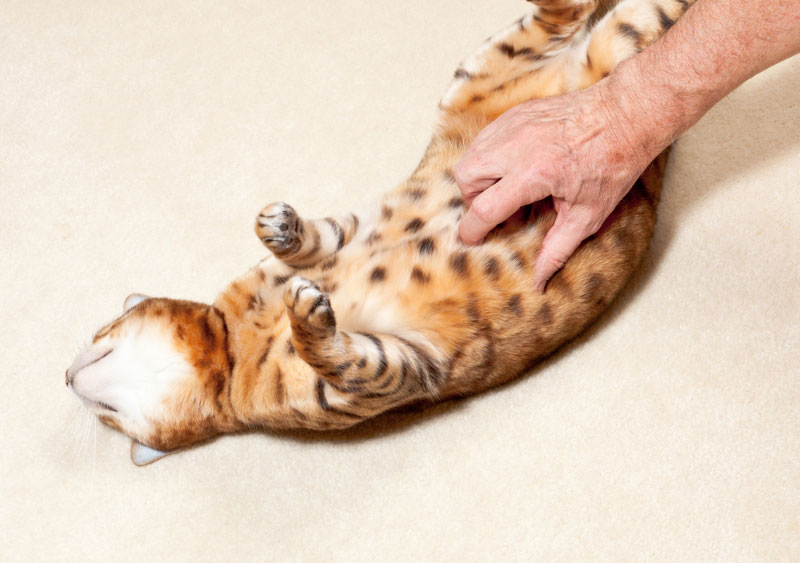
When It’s a Bad Idea to Tickle a Cat
If a cat gives you any signs that they would rather be alone, such as tail swishing, flattened ears, or walking away, leave them alone. Pursuing a cat that has communicated with you in this way will make the situation worse and lessen your chances of future interactions.
You should resist the urge to tickle a cat’s belly, even if they seem to offer it to you. When a cat rolls on their back and exposes their tummy to you, it is not an invitation to tickle it. They are demonstrating trust by exposing their most vulnerable part. You can be flattered and show appreciation by tickling them in a “safe” spot.
Cats that are sick or in pain may also not tolerate being tickled or petted. Sometimes when attempts to tickle a cat are met with a bad reaction or a flinch, this may indicate that something is wrong. It’s useful to be attentive to your kitty’s usual response to being tickled or caressed so that you can know an unusual response that could alert you to an injury or illness. You should seek veterinary advice if you notice that they seem uncomfortable or unhappy.
Final Thoughts
Cat lovers and animal experts agree; cats are ticklish, just not in the same way that humans are. There are similarities, but the differences must be understood and respected. This will enable you to provide your pet with pleasurable knismetic experiences rather than those that cause irritability and discomfort. For the kitty that loves a good scratch or tickle, nothing can induce greater pleasure and relaxation.
- See also: Do Cats Laugh? Vet Approved Facts & FAQ
Featured Image Credit: Konstantin Aksenov, Shutterstock


